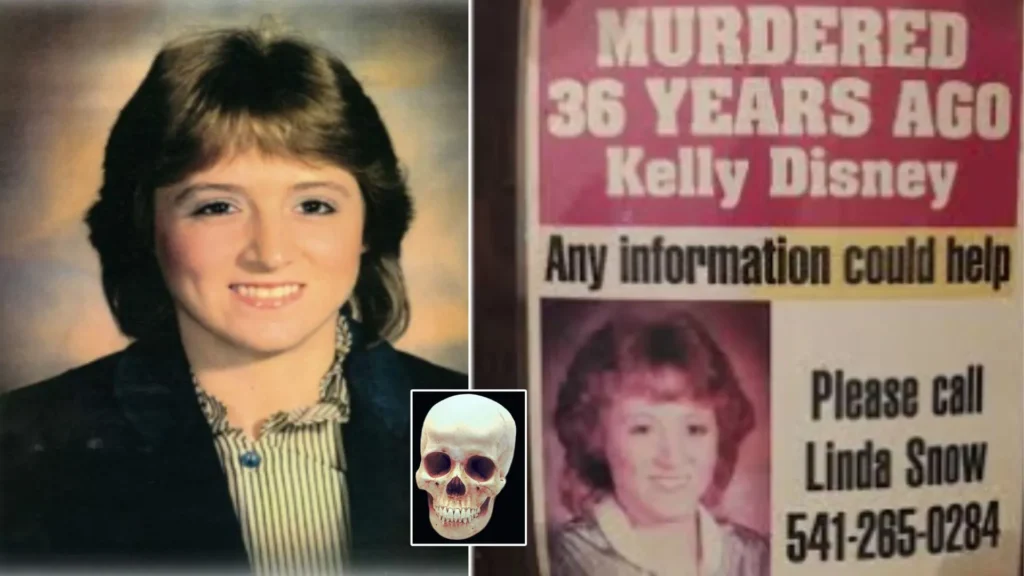
On March 9, 1984, before dawn, 17-year-old Kelly Lynn Disney was seen walking along U.S. Highway 20 in Newport, Oregon. According to KLCC, she turned down multiple offers of a ride, including one from a local police officer, saying she was on her way to a friend’s house.
Minutes later, Kelly went missing. As reported by KPTV, investigators at the time had no leads strong enough to explain what happened to her after she was last seen on the roadside.
A decade afterward, in 1994, a human skull was found in an abandoned car near Big Creek Reservoir. This discovery marked the first physical evidence connected to Kelly since her disappearance, shifting her case from a missing person file to a homicide investigation.
What happened to Kelly Lynn Disney in 1984?
Kelly Lynn Disney was a Newport High School student who grew up in the Siletz community as the eldest of four siblings. At 17, she was living in Newport with her fiancé, Robert Ellis, and was determined to build a future with him despite her young age.
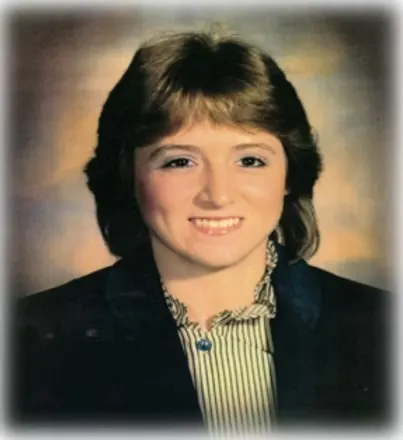
On the night of March 8, 1984, the couple hosted a small gathering at their Hurburt Street apartment in Newport. After Ellis briefly left, Kelly became upset. Around 12:30 a.m., she walked out of the apartment on her own, beginning the sequence of events that would mark her disappearance.
Ellis returned and, upon learning that Kelly had left, went searching. He spotted her standing along Highway 20 near the Highway 101 junction, but she refused to get into his car. Even in the rain and late hour, she insisted on continuing toward a friend’s house. Websleuths notes this detail in discussions of the case.
Not long after, two local men driving to work saw Kelly on the roadside. They pulled over and offered her a ride, but she declined. Concerned for her safety, the men later mentioned what they had seen to a police officer at a convenience market in Newport, prompting further attention.
A Lincoln County deputy soon located Kelly near what is now Southeast Moore Drive. He asked if she needed help, but she told him she was headed to a girlfriend’s house in the area and refused assistance. This encounter, at roughly 1:00 a.m. on March 9, 1984, became the last confirmed sighting of Kelly Lynn Disney.
Investigators later determined that there was a brief window of about 15 to 20 minutes after the deputy left when Kelly either willingly entered a vehicle or was taken by force. She was reported missing later that day. At the time, authorities leaned toward the possibility that she had left voluntarily, which slowed the urgency of the initial search.
Her sister Angela Dodds has maintained that Kelly was careful and unlikely to get into a car with a stranger. Dodds has stressed over the years that her sister was streetwise and “would never get into a car with someone she did not know.” Family members believed that if she entered a vehicle, it was with someone she trusted. Despite searches in the immediate aftermath, no clothing, belongings, or other physical evidence was ever recovered.
How was Kelly Lynn Disney’s skull discovered near Big Creek Reservoir?
In July 1994, investigators found the first physical evidence connected to the disappearance of Kelly Lynn Disney. Her skull was discovered inside an abandoned car near Big Creek Reservoir, just outside Newport. ABC News later described the wooded reservoir as a recreational spot, an unlikely place for the recovery of human remains.
The vehicle itself had a reputation as a local hangout where young people sometimes gathered to drink or party. Investigators later learned that neighborhood children had been around the same car the day before the discovery and saw nothing unusual, suggesting that Kelly’s skull had been placed there deliberately, years after her death.
Cold case investigator Linda Snow emphasized that timing was critical. She stated, “We know absolutely the day before it was found the skull was not there.” Snow noted that the remains appeared just days after authorities had gone to the media in 1994 to raise awareness, suggesting someone deposited the skull in direct response to that coverage.
The way the skull reached police added another layer of confusion. Reports at the time indicated that the person who discovered it, possibly a teenager exploring the abandoned car, did not immediately call authorities. Instead, he took the skull home, washed it with soap, and only turned it in the following day.
The unusual handling of evidence drew strong reactions. Observers questioned why anyone would scrub a human skull, with one remarking in disbelief, “Who the hell takes a human skull home and scrubs it clean???” Another commented that the skull seemed freshly placed, adding, “As for scrubbing the skull, I’ve got nothing. That is the most suspect aspect to me.”
Following the recovery, the state medical examiner confirmed through dental records that the skull belonged to Kelly Lynn Disney. Her cause of death could not be determined from the remains, and no other parts of her body were located. Authorities reclassified the disappearance as a homicide, but investigators had little physical evidence to pursue.
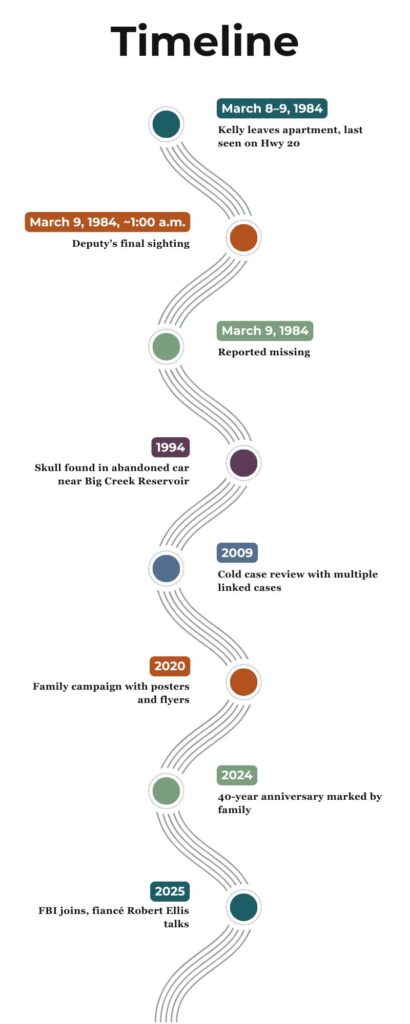
By the mid-1990s, DNA testing was still in its early stages. With the skull sanitized, there was almost nothing for forensic labs to analyze. As one report explained, “Besides ruling it a homicide, in the 20 years since, without evidence or the ability to use technology, solving the case has taken an old-school approach,” meaning detectives relied on interviews, tips, and old files.
For Kelly’s family, the 1994 discovery confirmed that she was no longer alive but provided almost no answers about what happened.
What theories guide the ongoing investigation into Kelly Lynn Disney’s murder?
In the years after the 1994 discovery, the Lincoln County District Attorney’s Office periodically reopened the case as a cold case homicide. A dedicated Cold Case Unit was eventually formed, and retired legal assistant Linda Snow volunteered to pursue leads. Investigators gradually shaped a theory they now consider highly plausible.
Based on statements and long-circulating rumors, detectives believe one or two people Kelly knew, likely from Siletz where she grew up, offered her a ride after 1 a.m. on March 9, 1984. “My guess is they said, ‘We’ll give you a ride home,’” Snow explained, noting that the route toward Siletz fit Kelly’s plans.
Investigators suspect that Kelly was instead taken to a secluded location and confronted by a group of young men. There, she was sexually assaulted and then killed to prevent her from speaking. Snow said later accounts pointed to witnesses who admitted privately that they had been present and regretted not stepping in.
“These men told others they were there when Disney was assaulted and wished they had stepped in to stop it,” Snow recounted, describing how separate conversations over the years produced the same scenario. “We do have this consistent line of stories…that they were there and that she had been killed.”
Authorities believe they know the likely identity of several local men involved but lack the physical evidence or decisive testimony to press charges. This absence of proof has left investigators unable to move the case forward despite confidence in the general outline of what happened that night.
Investigators sometimes note other long-running cases. Beatriz Winck’s disappearance in Brazil and Susan Powell’s case in Utah both show how families can wait years without resolution.
For many years no arrests were made, which fueled speculation. Some in the community wondered if a serial killer might have been responsible. Between 1984 and 1995, four other teenage girls were murdered or disappeared around Newport, including Jennifer Esson and Kara Leas in 1995, and Melissa Sanders and Sheila Swanson in 1992.
Police briefly considered that a single predator could be connected. In 2009, all five cases were reexamined together. Bobby Jack Fowler, a drifter linked to other Pacific Northwest crimes, was floated as a possible suspect. Still, investigators said they had “no hard evidence” tying all the killings.
Lincoln County’s then-DA Rob Bovett remarked, “Someone might decide to talk. DNA testing has changed, people have grown older and relationships have changed.” Investigators stressed that time could loosen lips, and they held hope that guilt or shifting loyalties might eventually push a witness to come forward with firsthand information.
Kelly’s family never stopped demanding answers. In 2020, relatives launched a public campaign by posting more than 200 signs and distributing 2,000 flyers across the Oregon coast. The message was blunt: “Justice for Kelly Disney. 36-year-old murder case.” Some of those posters still hang in shop windows and homes.
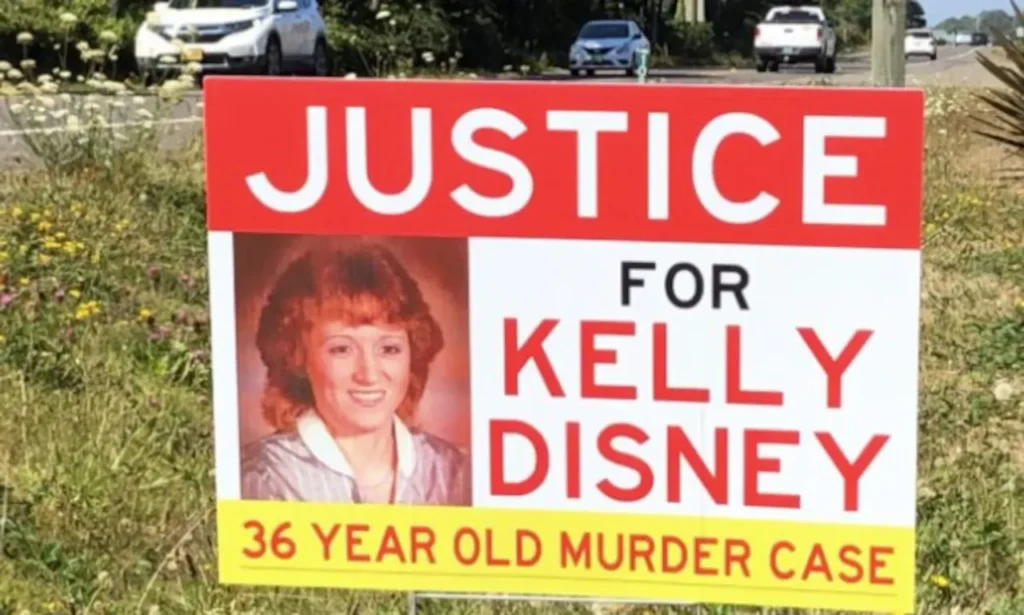
“It was awesome to see some still up,” Angela Dodds remarked in 2024, describing how weathered posters remained tacked up in Siletz years later. The family’s persistence kept the case visible in a tight-knit community, ensuring that Kelly’s name and story did not fade from local memory.
By 2025, law enforcement signaled new momentum. The FBI joined the case, bringing fresh expertise. Around the same time, Robert Ellis, Kelly’s former fiancé, finally provided investigators with new information after decades of silence. His cooperation surprised investigators, as Snow had once remarked, “He won’t talk to us,” while adding that she did not think he was responsible.
District Attorney Jenna Wallace told KPTV in March 2025 that “two key boosts” had given investigators hope of finally solving the case. Snow added that just one witness could make the difference, saying, “It could be one person that would push us over that edge, where we could say we have enough here to bring this case to a grand jury.”
Despite renewed efforts, Kelly’s remains have never been fully recovered. “We can’t put her to rest until the rest of her is in this box,” Angela Dodds said while holding the small urn that contained only her sister’s skull. At a community gathering, she pleaded, “Justice delayed is not justice at all… They got to graduate, raise families, put loved ones to rest – why can’t we do that for her?”
What photos and locations are tied to the Kelly Lynn Disney murder case?
Visual records have played an important role in keeping Kelly Lynn Disney’s case alive. After 1984, missing person flyers and bulletins were distributed, and her details were entered into national databases like NamUs. Her school portrait, showing a blonde, blue-eyed teenager, became the image most associated with her disappearance.
One of the most important locations remains the intersection of U.S. 20 and Moore Drive in Newport, where Kelly was last seen declining help from a deputy. Angela Dodds returned there in 2024 with her granddaughter, Peyton, marking four decades since the disappearance. “I just needed to be here,” she said.
A photo taken that year showed Angela standing with Peyton on the grass beside the highway. The spot itself is unremarkable, yet it became central to the case. Witnesses and police encountered Kelly here on March 9, 1984, and today it stands as a quiet memorial visited by her family.
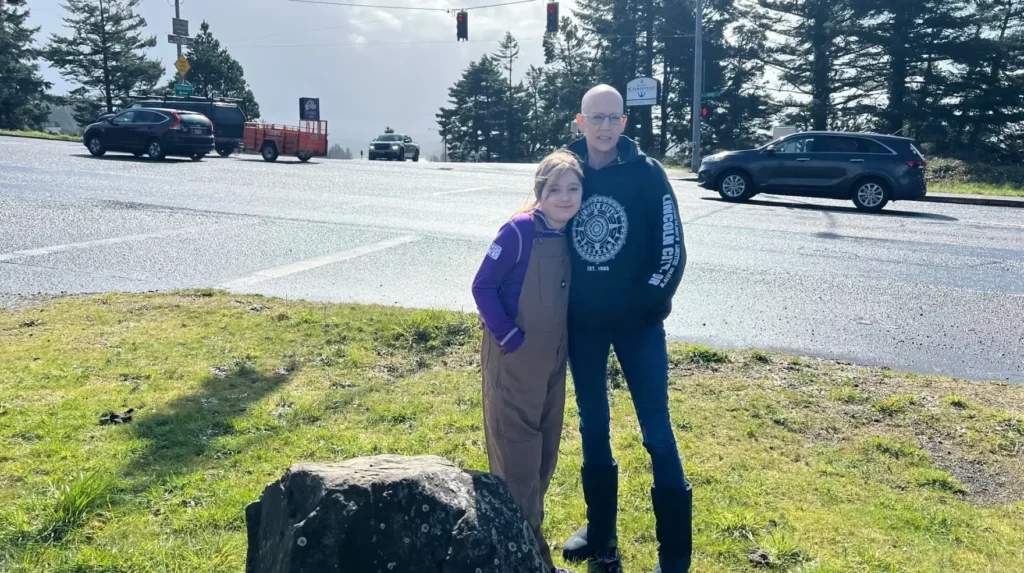
The Big Creek Reservoir site, north of Newport, has also become inseparable from the story. Its wooded landscape and gravel backroads offered the seclusion where an abandoned car could sit unnoticed for years. Maps show how Big Creek Road branches off Highway 101, making it accessible for someone driving locally or toward Siletz.
Law enforcement mapped out these locations during cold-case reviews: the Hurburt Street apartment, the stretch of highway where Kelly walked, and the reservoir where her skull was found. Plotting them revealed a trajectory from Newport’s center to remote woods, supporting investigators’ belief that Kelly was taken out of town toward isolation.
Images of direct evidence are scarce. Authorities retained the skull, but no photos have ever been released. Instead, age-progression composites circulated in the years before 1994, when investigators still hoped Kelly might be alive. Later, even a fiction novel borrowed from her story, its cover artwork echoing the haunting details.
These visual reminders keep the case in public memory. District Attorney Jenna Wallace said, “We kind of have to go back to that way of investigating, rely on the people… that knew Kelly.” Posters, photos, and maps are used to encourage tips from those who may still hold answers.
As of March 2025, the case remains unsolved. Investigators now believe they are close to resolution, citing FBI involvement and new information from Kelly’s circle. The Cold Case Unit continues to take tips at a dedicated hotline and email address, stressing that even decades later, one voice could unlock the truth.
For Kelly’s family, the goal has not changed. “We just want to bring her home,” Angela Dodds said, reflecting the enduring hope that her sister’s remains can be returned. Forty-one years later, Kelly Lynn Disney’s disappearance and murder remain open, but her name has never faded from Oregon’s collective memory.
If you have any information about Kelly Lynn Disney’s disappearance or homicide, please contact the Lincoln County District Attorney’s Office Cold Case Unit at 541-265-4145 or by email to dareception@co.lincoln.or.us. You may also reach Newport Police Detectives at 541-574-3348, or use their toll-free tip line 1-800-452-7888. Every piece of information, no matter how small, could help bring justice.
Commonly asked questions about Kelly Lynn Disney’s disappearance
Was Kelly Lynn Disney ever found?
No. Only her skull was discovered in 1994 near Big Creek Reservoir. The rest of her remains have never been located.
Who last saw Kelly Lynn Disney?
A Lincoln County deputy saw her walking along Highway 20 near Moore Drive around 1:00 a.m. on March 9, 1984.
What evidence was found in Kelly Lynn Disney’s case?
In 1994, her skull was placed in an abandoned car near Big Creek Reservoir. No other remains or belongings were recovered.
Is there a suspect in Kelly Lynn Disney’s murder?
Investigators believe men from the local Siletz community were involved, but no charges have been filed.
Is the Kelly Lynn Disney case still open?
Yes. As of 2025, the FBI is assisting Lincoln County authorities in the investigation.

